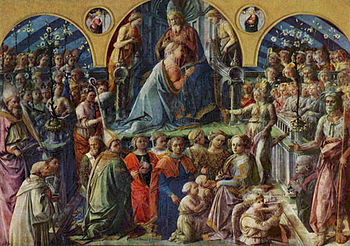- Incoronation of the Virgin (Filippo Lippi)
-
Incoronation of the Virgin 
Artist Filippo Lippi Year 1441-1447 Type Tempera on panel Dimensions 220 cm × 287 cm (87 in × 113 in) Location Uffizi, Florence The Incoronation of the Virgin (also known as Incoronazione Maringhi) is a painting by the Italian Renaissance master Filippo Lippi, housed in the Uffizi, Florence.
History
Francesco Maringhi, procuratore of the church of Sant'Ambrogio, after his death in 1441 left money for the realization of new canvas at the high altar of the church. Bills of the payments for the work until 1447 have been preserved.
In the late 1430s, brother Filippo Lippi had left the convent of the Carmine convent to open an artist workshop of his own; however, having no money enough to pay assistants and apprentices, he worked alone with two usual collaborators, Fra' Carnevale and Fra' Diamante, along with an unknown "Piero di Lorenzo dipintore". For this work Lippi had however to call in a total of six external painters, who were responsible also of the gilted frame, now lost. Originally the work had also a predella, also lost with the exception of a small panel with a Miracle of St. Ambrose, now in the Berlin State Museums.
The work was immediately admired and was copied by numerous painters. It remained in Sant'Ambrogio until 1810, when it was stolen. Later a private sold it to the Galleria dell'Accademia, from which it was later transferred to the Galleria degli Uffizi in Florence.
Description
The work is composed of a single panel, divided into three sectors by the arches. At the sides of the central arch are two tondos, depicting the Angel of Annunciation and the Virgin.
The main scene features a crowd of biblical figures, angels and saints, portrayed in informal positions; most of them are probably portraits of existing people. As usual, the scene is set in Heaven, but Lippi decided to avoid the outdated gilted background, replacing it with a striped sky which alludes to the seven sectors of the Paradise. In the middle, in a commanding position, are Christ and the kneeling Madonna who is going to be crowned, within a majestic marble throne in perspective. The latter includes the shell-shaped niche, featured in other paintings by Lippi.
Four angels are holding a gilted ribbon, while in the lower level is a series of kneeling saints; on the left and right are other two groups of saints and angels, inspired to the crowded choirs of older works, such as the Incoronation of the Virgin by Lorenzo Monaco. The elevated pavement of the side groups creates a perspective triangle whose apex is the Virgin's head.
Amongst the figures in the middle can be recognized: Mary Magdalene and St. Eustace (titular of one of the most important altars in the church) with his sons and his wife. These figures, all without a halo, are shorter than normal, as the painter imagined them to be correctly seen from below, in perspective, by the nuns of the Sant'Ambrogio convent from their separated choirs.
Kneeling at the side are the work's commissioner, facing a cartouche with the write IS PERFECIT OPUS ("this one finished the work"), while on the left is a self-portrait of Filippo Lippi in the garments of a Carmelite monk as he was. Standing on the sides are the two titular saints of the church: St. Ambrose (left) and St. John the Baptist (right), whose austere representation reveal the influence of Masaccio.
Sources
- __ (2003). Galleria degli Uffizi. Rome.
Categories:- 1440s paintings
- Filippo Lippi paintings
- Collections of the Uffizi
Wikimedia Foundation. 2010.
